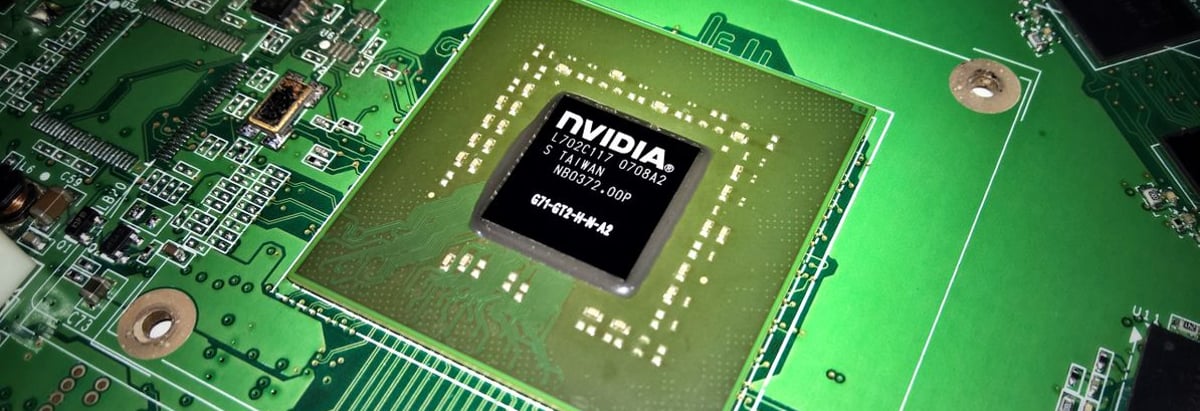Stock Analysis
- United States
- /
- Semiconductors
- /
- NasdaqGS:NVDA
NVIDIA (NASDAQ:NVDA) Seems To Use Debt Rather Sparingly

Some say volatility, rather than debt, is the best way to think about risk as an investor, but Warren Buffett famously said that 'Volatility is far from synonymous with risk.' So it seems the smart money knows that debt - which is usually involved in bankruptcies - is a very important factor, when you assess how risky a company is. We can see that NVIDIA Corporation (NASDAQ:NVDA) does use debt in its business. But is this debt a concern to shareholders?
Why Does Debt Bring Risk?
Debt is a tool to help businesses grow, but if a business is incapable of paying off its lenders, then it exists at their mercy. Part and parcel of capitalism is the process of 'creative destruction' where failed businesses are mercilessly liquidated by their bankers. While that is not too common, we often do see indebted companies permanently diluting shareholders because lenders force them to raise capital at a distressed price. Of course, debt can be an important tool in businesses, particularly capital heavy businesses. When we think about a company's use of debt, we first look at cash and debt together.
View our latest analysis for NVIDIA
How Much Debt Does NVIDIA Carry?
You can click the graphic below for the historical numbers, but it shows that NVIDIA had US$9.71b of debt in April 2024, down from US$11.0b, one year before. However, its balance sheet shows it holds US$31.4b in cash, so it actually has US$21.7b net cash.
How Strong Is NVIDIA's Balance Sheet?
Zooming in on the latest balance sheet data, we can see that NVIDIA had liabilities of US$15.2b due within 12 months and liabilities of US$12.7b due beyond that. Offsetting these obligations, it had cash of US$31.4b as well as receivables valued at US$12.4b due within 12 months. So it can boast US$15.9b more liquid assets than total liabilities.
Having regard to NVIDIA's size, it seems that its liquid assets are well balanced with its total liabilities. So it's very unlikely that the US$3.23t company is short on cash, but still worth keeping an eye on the balance sheet. Succinctly put, NVIDIA boasts net cash, so it's fair to say it does not have a heavy debt load!
Better yet, NVIDIA grew its EBIT by 956% last year, which is an impressive improvement. That boost will make it even easier to pay down debt going forward. There's no doubt that we learn most about debt from the balance sheet. But it is future earnings, more than anything, that will determine NVIDIA's ability to maintain a healthy balance sheet going forward. So if you're focused on the future you can check out this free report showing analyst profit forecasts.
Finally, a company can only pay off debt with cold hard cash, not accounting profits. NVIDIA may have net cash on the balance sheet, but it is still interesting to look at how well the business converts its earnings before interest and tax (EBIT) to free cash flow, because that will influence both its need for, and its capacity to manage debt. Over the last three years, NVIDIA recorded free cash flow worth a fulsome 82% of its EBIT, which is stronger than we'd usually expect. That positions it well to pay down debt if desirable to do so.
Summing Up
While it is always sensible to investigate a company's debt, in this case NVIDIA has US$21.7b in net cash and a decent-looking balance sheet. The cherry on top was that in converted 82% of that EBIT to free cash flow, bringing in US$39b. So we don't think NVIDIA's use of debt is risky. The balance sheet is clearly the area to focus on when you are analysing debt. But ultimately, every company can contain risks that exist outside of the balance sheet. Be aware that NVIDIA is showing 1 warning sign in our investment analysis , you should know about...
If, after all that, you're more interested in a fast growing company with a rock-solid balance sheet, then check out our list of net cash growth stocks without delay.
Valuation is complex, but we're helping make it simple.
Find out whether NVIDIA is potentially over or undervalued by checking out our comprehensive analysis, which includes fair value estimates, risks and warnings, dividends, insider transactions and financial health.
View the Free AnalysisHave feedback on this article? Concerned about the content? Get in touch with us directly. Alternatively, email editorial-team (at) simplywallst.com.
This article by Simply Wall St is general in nature. We provide commentary based on historical data and analyst forecasts only using an unbiased methodology and our articles are not intended to be financial advice. It does not constitute a recommendation to buy or sell any stock, and does not take account of your objectives, or your financial situation. We aim to bring you long-term focused analysis driven by fundamental data. Note that our analysis may not factor in the latest price-sensitive company announcements or qualitative material. Simply Wall St has no position in any stocks mentioned.
Valuation is complex, but we're helping make it simple.
Find out whether NVIDIA is potentially over or undervalued by checking out our comprehensive analysis, which includes fair value estimates, risks and warnings, dividends, insider transactions and financial health.
View the Free AnalysisHave feedback on this article? Concerned about the content? Get in touch with us directly. Alternatively, email editorial-team@simplywallst.com
About NasdaqGS:NVDA
NVIDIA
Provides graphics and compute and networking solutions in the United States, Taiwan, China, Hong Kong, and internationally.

